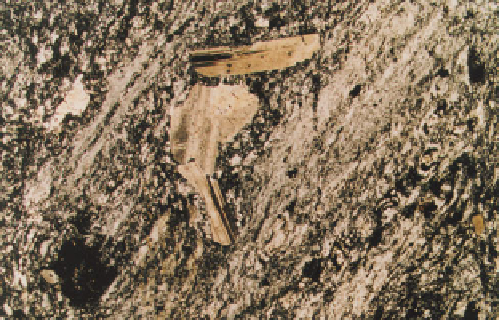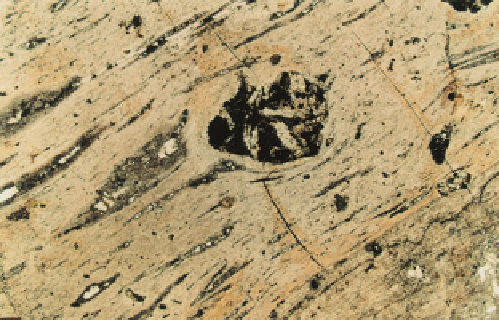Geoscience Reference
In-Depth Information
148
variously to cataclasite (
148
), ultracataclasite (
149
), and
ultramylonite (
150
). These rocks contain higher
proportions of disordered quartz and are likely to be
alkali-reactive (Wigum, 1996).
Quartzite and chert (and flint) are important rock types
when considering aggregate for concrete, as they are both
commonly used in concrete and are potentially alkali-
reactive. Classification of these rocks can be challenging
and with this in mind, Hunt (1995) has devised an
engineering classification of quartzite and chert to aid
alkali-silica reactivity assessment. The classification is
based on texture, fabric, and grain size definitions as
shown in
Table 16
. Using this classification, Figure
151
shows diaquartzite, Figure
152
shows metaquartzite, Figure
153
shows cherty quartzite, and Figure
77
shows chert.
AAR is discussed further on pp. 109-114.
148
Granite cataclasite with a porphyritic texture with
porphyroclasts of feldspar (centre) set in a groundmass
largely composed of finely crystalline quartz; XPT,
×35.
149
150
149
Ultracataclasite consisting of an unfoliated
groundmass of finely crystalline to cryptocrystalline
silica, with rare strained porphyroclasts; XPT, ×35.
150
Ultramylonite with a foliated groundmass of
finely crystalline to cryptocrystalline silica, with rare
strained porphyroclasts; XPT, ×35.
Table 16
Classification of the quartzite group of rocks (from Hunt, 1995)
TEXTURE
0%
5%
50%
95%
100%
(Ortho)quartzite
Diaquartzite
Metaquartzite
Cherty quartzite
Cherty diaquartz
Cherty metaquartz
Quartzitic chert
Quartzitic diachert
Quartzitic metachert
Chert
Diachert
Metachert
Original grain
No original grain structure,
Interlocking crystals,
structure visible
interlocking crystals
visible restructuring
INCREASING MATURITY






